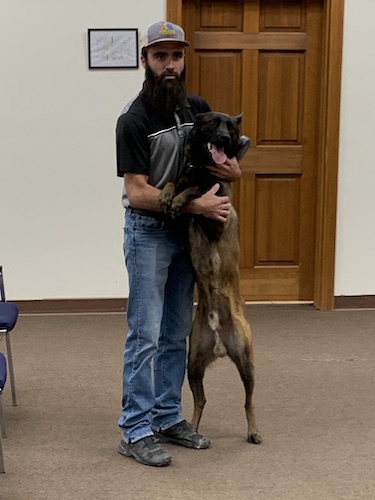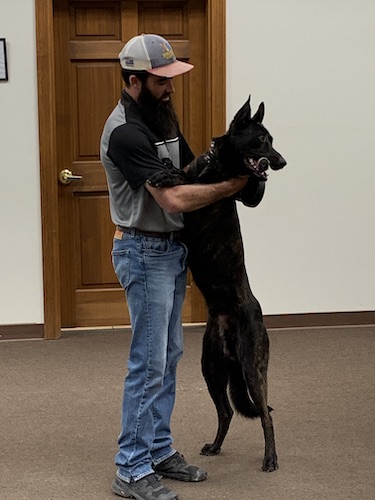[Editor's Note: This is the second presentation of the Grant County Commission work session on July 6, 2021.]

 Photos and article by Mary Alice Murphy
Photos and article by Mary Alice Murphy
Marty Madden of Xcelsior K-9 Police Service Dog Training out of Las Cruces, brought two dogs, both from The Netherlands and about to begin training, to the Grant County Commission meeting while Undersheriff Jess Watkins explained the proposal to the commission for the department to have a narcotic detecting and tracking dog
Grant County Undersheriff Jess Watkins said he was doing the presentation because Sheriff Frank Gomez was unable to attend. "The Sheriff has been working on a proposal for a K-9 program within the department. The primary purpose for the canine is to detect narcotics. The secondary purpose is for tracking. It would not be a patrol dog and would not bite. The canine would also serve our D.A.R.E. program. We will select a handler out of our existing staff and make a unit out of our existing fleet. The canine would be selected by the trainer. The kennel will be located at the handler's resident. We will look for outside sources of funding, which will be about $32,000 including the dog, the training, outfitting the vehicle and the kennel."
He reported he had just attended the HIDTA (High-Intensity Drug Trafficking Area) task force meeting for the entire region 7. "Last year, even though it was kind of a slow year with the pandemic, the task force seized 54 pounds of methamphetamine, 12 pounds of heroin, 13 pounds of cocaine and six pounds of fentanyl, just a couple of grains of which can kill someone. I think bringing a canine in would be very beneficial."
Watkins introduced Marty Madden of Xcelsior K-9 Police Service Dog Training out of Las Cruces.
"I specialize in buying, training and selling police K-9s to law enforcement departments," Madden said. "I was raised in K-9 training in California, which has more K-9 police dogs than anywhere else in the world. Before the four weeks of training, I meet with the department, and I will help you select the handler. It's a big step to do this program. Once you find the right person, I will find the right dog for the department and the handler. The handler will be certified after the four weeks of 8-to-12-hour days, five days a week. At the end of the training, they will have a national certification and some in-house certifications. I never have more than five people in a class. I can train them here at school facilities, which will save the cost of your having to ship the dog out to me in Las Cruces."
District 2 Commissioner Javier "Harvey" Salas asked the age of the dog.
Madden said the dogs can be anywhere from six months old to 5 years old. "I usually choose ones that are older than 1 year of age, because they are stable structurally. I have two dogs with me today. They are in pre-training and start school on Monday. There are big variables in the physical structure of a dog. Five to six years is a short term for a dog to be in service. Those that make six to eight years have a good life. My dad trained a dog that we had for 15 years, and he worked for 14 of them. They will not be a patrol dog here, so the dog will last longer. They won't be playing football; they'll be playing golf most of the time."
Salas said he has seen them in action, and they are amazing. Madden agreed and said, even with all the technology, dogs are the best at locating narcotics.
District 5 Commissioner Harry Browne, calling in over the telephone, asked to clarify the officer in charge of the dog. The program will pay for the maintenance and kennel, but will the handler receive an incentive.
Watkins said: "I don't see us planning any incentive."
Browne clarified that the handler is in charge of the dog on and off duty.
Madden said most departments have an incentive, but it may not be monetary. It might be 30 minutes off the workday, so the handler can clean the kennel, feed them and take them out. "That's what I've seen. If the handler is going on vacation, for instance, I often take the dog for a week or so."
District 4 Commissioner Billy Billings, who also attended by phone, said he had no questions, but it was an excellent presentation.
District 3 Commissioner Alicia Edwards asked what would happen if a vehicle were pulled over and a narcotic is suspected.
"You can't delay the scene," Madden said. "The dog needs to be on the scene or really close by. To run the exterior of a car takes the dog 45 seconds or less."
Edwards noted Grant County is a "really big county."
Madden and everyone else laughed when he said: "I think you should get three dogs. It's realistic that you are not going to catch every narcotic that comes down the road."
Edwards asked if the dog would be taken to events.
Watkins said: "Absolutely, not only as a deterrent but for public relations. We try to have the handler and the dog at the right time of day and at locations where there is the highest chance of catching narcotics. If a vehicle is impounded, we use the dog to search it for narcotics and then a search warrant is that much easier to get. Even though it wouldn't be on duty 24 hours a day, when it is on duty, the usefulness we would get out of it is just outstanding."
Edwards asked if a K-9 would enhance HIDTA or is there a broader purpose.
Watking said it would absolutely enhance those services, especially where the problems are down on I-10. "That's another thing we might look at, HIDTA might even have some reimbursement for the training or overtime."
County Manager Charlene Webb asked if it would be appropriate to use the dog at the Detention Center for a sweep once in a while.
Madden said yes and that he trained the dog for Doña Ana County, and they got a lot of stats. "The one that surprised me was the mail. The ladies would go through the mail and put it in shoe boxes. A dog would get a hit on a box and then we would start going through the envelopes. This dog has a lot of uses. The public relations part is great. The dogs are the superstars when you show up at a school. 'You have a police dog at your house?' Not everyone likes cops, but I've met very few who don't like dogs. You get a really good connection with people that you would never think you would get. And with the Silver Alerts and the missing children, maybe an autistic kid that wanders off, this dog is a tracking dog. It doesn't bite. When the dog finds someone, they come around the corner wagging their tail and they get a toy."
Edwards laughed and said: "I can see us having three really soon."
Salas said: "That will be one person assigned to the dog."
Madden said the person and the dog would be certified as one team.
Salas asked if that would take an officer out of rotation.
Watkins said the person would be from existing staff. The handler and the dog will not be on full patrol but will go out on patrol and will get called out if there is a criminal investigation. "We don't expect personnel growth with this person."
District 1 Commissioner and Chair Chris Ponce said he knows a dog is a great tool for the department. "Have you looked at the budget?"
Webb said she and the sheriff have met. "I suggested absorbing it into the sheriff's budget. We had the discussion and we also brought it to Linda (Vasquez, financial officer)."
Ponce said he could see overtime, too. "But I've seen how it works. It's great."
Salas asked why the vehicle cost is so high.
Madden said he suggested heat sensors for the vehicle that is outfitted for the dog. "If it goes off, the officer cannot turn it off and Dispatch is notified. The window goes down and finally the door will pop open. The annual cost of training includes me. I train the team every month in an 8-hour shift. It's insurance for you so that the team's training stays up to date. It costs about $1,800 a year for maintenance."
Browne said Madden had mentioned four controlled substances, but now that marijuana is legal, is it still the four?
Madden said he is no longer training dogs on marijuana. "We only test them on three odors, cocaine, heroin and methamphetamine."
Edwards asked if they can smell fentanyl. Madden explained that heroin has 428 odors inside the actual odor of heroin. "Fentanyl is just an additive. Usually when the drugs are being made, they are near each other, so we train on 100 percent pure. When the dogs are on the street and it's 50 percent or 60 percent heroin, the dogs smell it. We've gotten hits off ecstasy pills, and we've never trained on ecstasy pills. You find a lot and often it also leads to money, because the money is right next to the dope."
Madden said he had two dogs with him and would walk them through for the commissioners to see.
Watkins said a few weeks ago, the office put out a notice to see if anyone was interested. "We had two responses. My wife and I shared a police dog, so we had it available day and night. It's a handful, you're asking a lot of the officer. but the dogs are an awesome tool."
Madden brought in a dog from the Netherlands that after training will be going to Alamogordo. "He's a dual-purpose dog, for bite and dope."
Edwards asked if there is an increase in substances found with those departments that have dog. Watkins said he didn't have the statistics, but would get them.
Madden brought in Jago, also from the Netherlands. "Even though he's a bite dog, he's very friendly. My wife takes him out and he's friendly to everybody. He's a handful, but he's for a guy who's 6'3", so he wanted a big dog."
The next article will begin with county reports and then get into the review and actions of the regular meeting agenda.